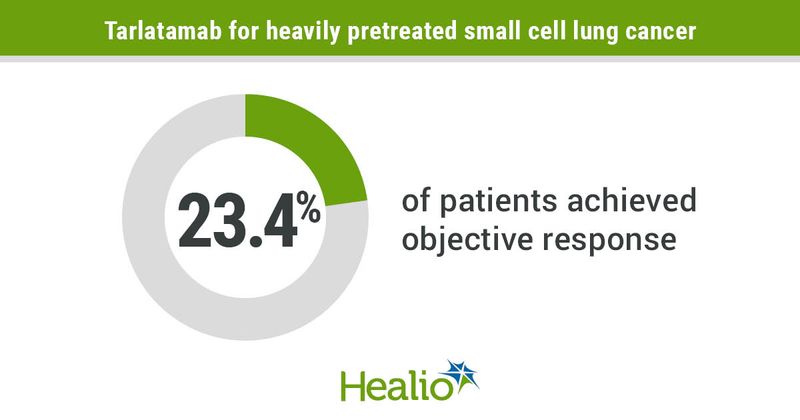Tarlatamab active in recurrent small cell lung cancer
Tarlatamab showed encouraging response durability among heavily pretreated patients with small cell lung cancer, according to study results.
The agent also exhibited a manageable safety profile, according to investigators.

Small cell lung cancer is the most aggressive lung cancer subtype. Treatment options are limited.
Delta-like ligand 3 (DLL3) is highly expressed in this patient population.
Tarlatamab (Amgen) is a first-in-class DLL3-targeted bispecific T-cell engager. It binds to DLL3 and CD3, resulting in T cell-mediated tumor lysis, according to study background.
Luis Paz-Ares, MD, PhD, chair of the department of medical oncology at Hospital Universitario 12 de Octubre in Madrid, Spain, and colleagues conducted an open-label phase 1 study to assess tarlatamab for patients with relapsed or refractory small cell lung cancer.
Safety served as the primary endpoint. Antitumor activity, OS and pharmacokinetics served as secondary endpoints.
The analysis included 107 patients treated with tarlatamab as of July 19, 2022. Study participants had received a median two (range, 1-6) prior lines of anticancer therapy, and half (49.5%) had received anti-PD-1/anti-PD-L1 therapy.
More than two-thirds (68.2%) received treatment in a dose-exploration cohort (0.003 mg to 100 mg), and about one-third received treatment in a dose-expansion cohort (100 mg).
Most patients (90.7%) experienced any-grade treatment-related adverse events, the most common of which was cytokine release syndrome (any grade, 52%; grade 3, 1%), with 33 patients (30.8%) experiencing any grade 3 or higher event.
Researchers reported one grade 5 case of pneumonitis.
The maximum-tolerated dose had not been reached.
Investigators reported an objective response rate of 23.4% (95% CI, 15.7-32.5), with two complete responses and 23 partial responses. Median duration of response was 12.3 months (95% CI, 6.6-14.9).
Results showed a disease control rate of 51.4% (95% CI; 41.5-61.2), with median PFS of 3.7 months (95% CI; 2.1-5.4) and median OS of 13.2 months (95% CI; 10.5 to not reached).
“Exploratory analysis suggests that selecting for increased DLL3 expression can result in increased clinical benefit,” Paz-Ares and colleagues wrote. “Further evaluation of this promising molecule is ongoing.”

